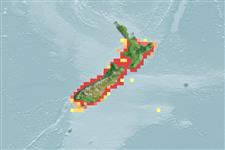>
Clupeiformes (Herrings) >
Clupeidae (Herrings, shads, sardines, menhadens)
Etymology: Sprattus: Old German, sprotte (1611) = a small fish, Clupea sp. (Ref. 45335).
Environment: milieu / climate zone / depth range / distribution range
Ecología
marino; rango de profundidad 0 - 72 m (Ref. 58489). Subtropical; 37°S - 48°S, 166°E - 180°E (Ref. 188)
Southwest Pacific: New Zealand.
Tamaño / Peso / Age
Maturity: Lm ? range ? - ? cm
Max length : 12.0 cm SL macho / no sexado; (Ref. 188); common length : 9.0 cm SL macho / no sexado; (Ref. 188)
Short description
Claves de identificación | Morfología | Morfometría
Espinas dorsales (total) : 0; Radios blandos dorsales (total) : 13 - 21; Espinas anales: 0; Radios blandos anales: 12 - 23; Vértebra: 48 - 51. Upper jaw rounded and not notched on frontal view. Gill cover without bony radiating striae; tooth plate on tongue broad, almost oval, width about 3 times in length, lateral teeth strong; scales with fine radiating or horizontal striae on exposed posterior part; back steel blue when fresh. Pterotic bulla absent. Last two anal rays normal.
A schooling species in coastal waters. The biology probably resembles that of S. muelleri from which it has not usually been distinguished in earlier studies. Tends to occur in the bottom or midwater except during summer when surface shoals may appear; extends to deeper water in summer and retreats to close inshore for spawning during winter (Ref. 9258). Reported from surface (Ref. 188) to 72 m (Ref. 58489).
Life cycle and mating behavior
Maturities | Reproducción | Spawnings | Egg(s) | Fecundities | Larva
Whitehead, P.J.P., 1985. FAO Species Catalogue. Vol. 7. Clupeoid fishes of the world (suborder Clupeoidei). An annotated and illustrated catalogue of the herrings, sardines, pilchards, sprats, shads, anchovies and wolf-herrings. FAO Fish. Synop. 125(7/1):1-303. Rome: FAO. (Ref. 188)
IUCN Red List Status (Ref. 130435)
Threat to humans
Harmless
Human uses
Pesquerías: pesquerías de subsistencia; carnada: occasionally
Herramientas
Special reports
Download XML
Fuentes de Internet
Estimates based on models
Preferred temperature (Ref.
123201): 10.9 - 18.2, mean 16.1 °C (based on 38 cells).
Phylogenetic diversity index (Ref.
82804): PD
50 = 0.5312 [Uniqueness, from 0.5 = low to 2.0 = high].
Bayesian length-weight: a=0.00708 (0.00349 - 0.01438), b=3.11 (2.93 - 3.29), in cm total length, based on LWR estimates for this (Sub)family-body shape (Ref.
93245).
Nivel trófico (Ref.
69278): 2.8 ±0.2 se; based on size and trophs of closest relatives
Resiliencia (Ref.
120179): Alto, población duplicada en un tiempo mínimo inferior a 15 meses (Preliminary K or Fecundity.).
Fishing Vulnerability (Ref.
59153): Low vulnerability (10 of 100).
